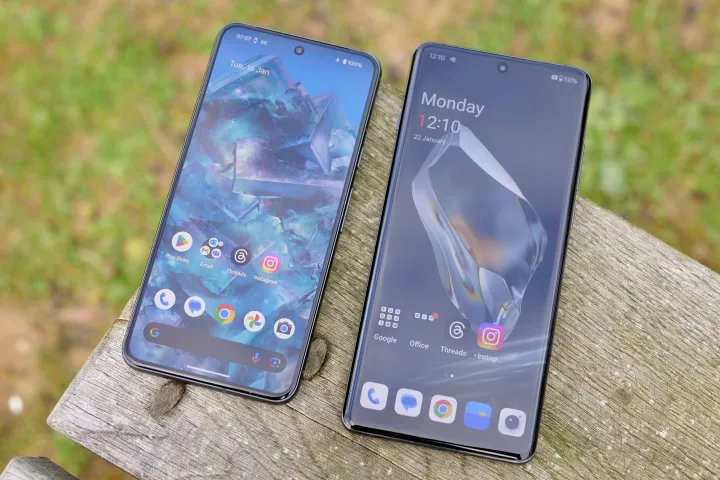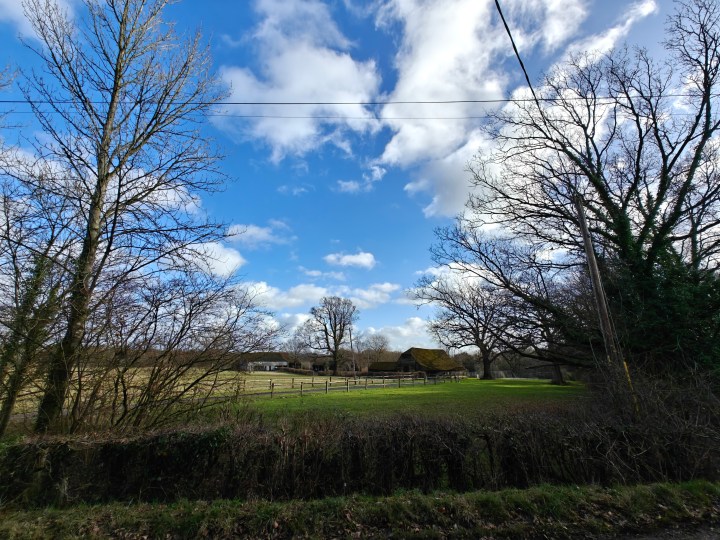
The OnePlus 12 is every bit a worthy successor to the brilliant OnePlus 11, and the camera is shaping up to be one of the brand’s highest specced yet. But what happens when it meets the Google Pixel 8?
The Pixel 8 is one of the best camera phones you can get and is even cheaper than the OnePlus 12, so if you want to take a lot of photos, which one will serve you better? We find out in our comprehensive test.
Comparing the camera specs

The OnePlus 12 is the first smartphone to use Sony’s LYT-808 50-megapixel camera, which promises better performance and more detail in all lighting conditions, and the 1/1.4-inch sensor has optical image stabilization (OIS) and an f/1.6 aperture. The 64MP OmniVision OV54B periscope zoom is also a first for phones and provides a 3x optical zoom and a 6x hybrid zoom, plus it also has OIS. Finally, there’s a 48MP wide-angle camera with a 114-degree field of view.
OnePlus has added a new HDR algorithm to the OnePlus 12’s camera software, and partner Hasselblad has tuned the Portrait Mode to include two different simulated focal lengths — a 50mm medium zoom at 2x and a 70mm for close-up shots at 3x. The selfie camera has 32 megapixels and electronic image stabilization.

On paper, the Google Pixel 8’s camera is easily beaten by the OnePlus 12, as it “only” has two cameras and no periscope camera or optical zoom. A 12MP wide-angle camera joins the 50MP main camera, with a 10.5MP selfie camera on the front. Working behind the scenes is Google’s always-excellent camera software, which shouldn’t be underestimated.
If you think the OnePlus 12 has the win in the bag already, don’t be so quick to judge, as when we put the Pixel 8 against the OnePlus 11, Google’s phone still managed to come out on top. However, it was very close, so has OnePlus done enough with the sequel to take down the Pixel 8 this time?
All the photos below were taken in automatic mode, video wasn’t included in the test, and images have been resized for easier online viewing.
Main camera
- 1. OnePlus 12
- 2. Google Pixel 8
There are some very interesting differences between the Pixel 8 and OnePlus 12’s main cameras, and it really does seem as if OnePlus and Hasselblad have found success in bringing out a specific character and style for its photos. The first photo is a simple one, taken on a very crisp winter afternoon, and you can see how the OnePlus 12 uses color and contrast differently from the Pixel 8.
- 1. OnePlus 12
- 2. Google Pixel 8
The way the two cameras expose shots affects the balance, too, with the second image demonstrating how tones and shades change. The lighting in the doorway in the Pixel 8’s photo looks great but is overexposed in the OnePlus 12’s photo, affecting the depth of reflection in the glass above it. The warmer tones of the OnePlus 12’s photo do make the scene more attractive than the colder, clinical Pixel 8’s photo.
- 1. OnePlus 12
- 2. Google Pixel 8
You can see the OnePlus 12’s warmer tones in the next photo too, but also how focal lengths differ compared to the Pixel 8, with one favoring the toast and the other the coffee cup. The Pixel 8’s better white balance is noticeable, as is its generally sharper focus and detail.
- 1. OnePlus 12
- 2. Google Pixel 8
In the last photo, you continue to see differences in tone, white balance, and color, but it also shows where the OnePlus 12 can smooth images out compared to the Pixel 8. There’s more detail and texture from the Pixel 8, and while I like the warmth of the OnePlus 12’s image, the smoothness takes away some of the realism.
It’s a trend we’re going to continue to see, and it means that although the OnePlus 12’s main camera performs very well, it has some problems that need fixing, while the Pixel 8’s camera is more rounded immediately.
Winner: Google Pixel 8
Wide-angle photos
- 1. OnePlus 12 wide angle
- 2. Google Pixel 8 wide angle
Our first wide-angle photo continues the concerning trend where the OnePlus 12 has a tendency to smooth things out quite a lot, losing detail in the process. The telephone booth is old and weathered, which shows in the Pixel 8’s photo, but is far less evident in the OnePlus 12’s. The lack of detail and excessive smoothing is evident in the background, too, plus the red color is more orange than in the Pixel 8’s photo.
- 1. OnePlus 12 wide angle
- 2. Google Pixel 8 wide angle
It’s not always quite so obvious, but the smoothness is usually there in the OnePlus 12’s wide-angle photos. In this wider scene, the wooden bridges and the grass bank around the lake are far less defined in the OnePlus 12’s photo, for example. The Pixel 8’s tone and brightness make it a happier, more inviting scene than the low-contrast, shadowy OnePlus 12 photo.
- 1. OnePlus 12 ultrawide angle
- 2. Google Pixel 8 wide angle
Our final wide-angle photo shows how these aspects together make the OnePlus 12’s wide-angle photos less visually appealing than the Pixel 8’s. The high contrast colors and detail-obscuring shadows ruin the OnePlus 12’s photo, and it looks completely different from the Pixel 8’s brighter, well-balanced shot. The scene in real life was closer to the Pixel 8’s image, too.
Winner: Google Pixel 8
Lowlight photos
- 1. OnePlus 12
- 2. Google Pixel 8
Given what you’ve seen from the cameras already, the first photo in our lowlight test will be a surprise. Shooting into the setting sun, the OnePlus 12 turned the difficult conditions into an attractive, realistic photo, while the Pixel 8 struggled to make the best of the environment. It seems the Sony LYT-808’s lowlight claims are accurate.
- 1. OnePlus 12
- 2. Google Pixel 8
The trend continues when it gets very dark, with the OnePlus 12 balancing the external darkness and the shop lights very effectively and showing less noise in the vehicles and road surfaces, too. It’s not perfect, with edge enhancement clear on the roofline, but you can also spot similar issues with the Pixel 8’s photo.
- 1. OnePlus 12
- 2. Google Pixel 8
Both struggle when it’s very dark, as the photo of the streetlight shows. The OnePlus 12 exposes the light better than the Pixel 8, but the surroundings are less detailed and muddier. But it has brought out more color than the Pixel 8. Surprisingly, the OnePlus 12 usually produces a more balanced, better exposed, and more detailed lowlight photo than the Pixel 8.
Winner: OnePlus 12
Zoom modes
- 1. OnePlus 12
- 2. Google Pixel 8 2x zoom
Before we get going, just a quick note: The Pixel 8’s zoom photos look differently framed than the OnePlus 12’s, despite both sharing the same zoom levels in the app. Let’s start with the 2x zoom, which is the only shortcut in the Pixel 8’s camera app. It’s much better than the OnePlus 12’s 2x mode, which is also an option in the app, showing more detail and more accurate colors every time.
- 1. OnePlus 12 3x zoom
- 2. Google Pixel 8 3x zoom
Moving on to the 3x zoom, this is where the OnePlus 12 should shine, as it’s the only truly optical zoom mode among the pair. However, it’s slightly disappointing. The photo of the tire shows it can pull in the detail, but it also shows quite a lot of smoothing once again, and the texture that exists in the Pixel 8’s photo is lost.
- 1. OnePlus 12 3x zoom
- 2. Google Pixel 8 3x zoom
The second 3x zoom photo of the doorway shows the OnePlus 12’s warmth once again, but there is very little difference between the clarity of the text between the two. The stairs behind the glass are sharper than in the Pixel 8’s photo, though, but look carefully at the metal paneling on the door itself, and you can see more smoothing in the OnePlus 12’s image.
- 1. OnePlus 12 6x zoom
- 2. Google Pixel 8 6x zoom
What about 6x zoom? The OnePlus 12’s camera app has a shortcut to this zoom mode, while the Pixel 8 has to be manually set to match it. The OnePlus 12’s 6x zoom is a hybrid, but it has impressed a lot, and this photo shows why. See the amount of detail in the Lego script on the bricks and the lovely natural bokeh in the shot too. The Pixel 8 can’t get close.
All this has made the zoom section quite difficult to judge. At 2x, the Pixel 8 is superior, and at 6x, the OnePlus 12 is superior. But neither is stellar at 3x, which is where the OnePlus 12 should really pull ahead. I am using the OnePlus 12 ahead of launch (with the final software version available to me installed), so this may improve with an update in the future. For now, however, it’s going to be a tie.
Winner: Draw
Selfie camera
- 1. OnePlus 12
- 2. Google Pixel 8
The OnePlus 12’s selfie camera has a much wider field of view than the Pixel 8 by default and gives a much stronger bokeh effect, too. There are considerable differences in texture, skin tones, and color, with the Pixel 8 taking a far more realistic and natural photo than the OnePlus 12. However, despite (or because of?) the smoothing, I prefer the wider OnePlus 12 photo, but I appreciate it’s not technically superior.
Winner: Draw
The Pixel 8 wins, but only just

The Pixel 8 has taken one more category win than the OnePlus 12, meaning it is our overall winner, but the pair have tied in two categories, showing the test has been a close run thing. It’s also interesting the OnePlus 12 has beaten the Pixel 8 in lowlight photography, a category most would expect the Pixel 8 to win. It seems the new Sony camera’s lowlight performance claims are accurate.
It’s unfortunate the wide-angle camera is a disappointment on the OnePlus 12, as the main camera can take some excellent photos; plus, there are some clear issues with the zoom camera that need fixing. The smoothing noticeable in many photos has cost the OnePlus 12 dearly in this test. I’ve been testing the phone ahead of launch, and it wouldn’t be the first time OnePlus has improved the camera through software updates after it was released.
For now, the Pixel 8 is still the recommended purchase if you want a great all-around camera phone without spending too much money, but the OnePlus 12 has a lot of strengths, and it’s also obvious there’s plenty of potential, too. It’s one to watch, but the Pixel 8 is really the one to buy today.






























